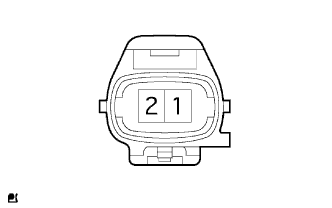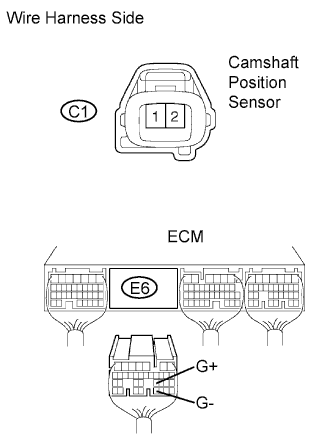Dtc P0340/12 Camshaft Position Sensor A Circuit (Bank 1 Or Single Sensor)
DESCRIPTION
WIRING DIAGRAM
INSPECTION PROCEDURE
INSPECT CAMSHAFT POSITION SENSOR (RESISTANCE)
CHECK WIRE HARNESS (CAMSHAFT POSITION SENSOR - ECM)
CHECK CAMSHAFT POSITION SENSOR (INSTALLATION)
CHECK PUMP DRIVE SHAFT PULLEY
DTC P0340/12 Camshaft Position Sensor "A" Circuit (Bank 1 or Single Sensor) |
DESCRIPTION
The camshaft position sensor (G signal) consists of a magnet, iron core and pickup coil.The G signal plate has 5 teeth on its outer circumference and is installed in the pump drive shaft pulley. When the pump drive shaft pulley rotates, the protrusion on the signal plate and the air gap on the pickup coil change, causing fluctuations in the magnetic field and generating an electromotive force in the pickup coil.The NE signal plate has 34 teeth and is mounted on the crank angle sensor plate. The NE signal sensor generates 34 signals at every engine revolution. The ECM detects the standard crankshaft angle based on the G signal and the actual crankshaft angle and the engine speed by the NE signal.DTC No.
| DTC Detection Condition
| Trouble Area
|
P0340/12
| When either condition below is met:
- No camshaft position sensor signal to ECM while cranking
(1 trip detection logic)
- No camshaft position sensor signal to ECM at engine speed of 650 rpm or more
(1 trip detection logic)
| - Open or short in camshaft position sensor circuit
- Camshaft position sensor
- Pump drive shaft pulley
- ECM
|
WIRING DIAGRAM
Refer to DTC P0335/12 (Toyota Fortuner RM0000012WS006X_02.html).
INSPECTION PROCEDURE
- HINT:
- Read freeze frame data using the intelligent tester. Freeze frame data records the engine conditions when a malfunction is detected. When troubleshooting, freeze frame data can help determine if the vehicle was running or stopped, if the engine was warmed up or not, and other data from the time the malfunction occurred.
- NOTICE:
- If the ECM is replaced, the new ECM needs initialization (Toyota Fortuner RM0000012X2005X.html).
| 1.INSPECT CAMSHAFT POSITION SENSOR (RESISTANCE) |
Disconnect the C1 sensor connector.
Measure the resistance of the position sensor.
- Standard resistance:
Tester Connection
| Condition
| Specified Condition
|
1 - 2
| Cold
| 835 to 1,400 Ω
|
1 - 2
| Hot
| 1,060 to 1,645 Ω
|
- NOTICE:
- In the chart above, the terms "cold" and "hot" refer to the temperature of the sensor. "Cold" means approximately -10 to 50°C (14 to 122°F). "Hot" means approximately 50 to 100°C (122 to 212°F).
- HINT:
- While cranking or idling the engine, check the waveform of the ECM connectors using an oscilloscope.
- Reference:
Tester Connection
| Specified Condition
|
E6-23 (G+) - E6-31 (G-)
E7-27 (NE+) - E7-34 (NE-)
| Correct waveform is as shown
|
Tool Setting
| Condition
|
5 V/DIV., 20 msec./DIV.
| Idling with warm engine
|
- HINT:
- The waveform varies depending on the engine speed.
| | REPLACE CAMSHAFT POSITION SENSOR |
|
|
| 2.CHECK WIRE HARNESS (CAMSHAFT POSITION SENSOR - ECM) |
Disconnect the C1 sensor connector.
Disconnect the E6 ECM connector.
Measure the resistance of the wire harness side connectors.
- Standard resistance:
Tester Connection
| Specified Condition
|
C1-1 - E6-23 (G+)
| Below 1 Ω
|
C1-2 - E6-31 (G-)
| Below 1 Ω
|
C1-1 or E6-23 (G+) - Body ground
| 10 kΩ or higher
|
C1-2 or E6-31 (G-) - Body ground
| 10 kΩ or higher
|
| | REPAIR OR REPLACE HARNESS AND CONNECTOR |
|
|
| 3.CHECK CAMSHAFT POSITION SENSOR (INSTALLATION) |
Check the sensor installation.
- OK:
- Sensor is installed correctly.
| | SECURELY REINSTALL CAMSHAFT POSITION SENSOR |
|
|
| 4.CHECK PUMP DRIVE SHAFT PULLEY |
Check the teeth of the pump drive shaft pulley.
- OK:
- Pulley's teeth do not have any cracks or deformation.
| | REPLACE PUMP DRIVE SHAFT PULLEY |
|
|



